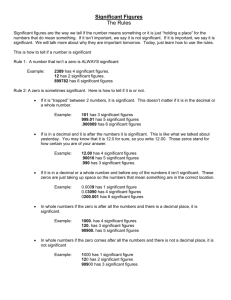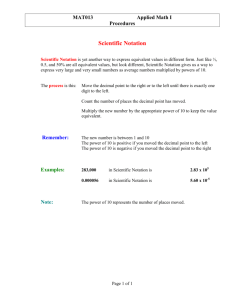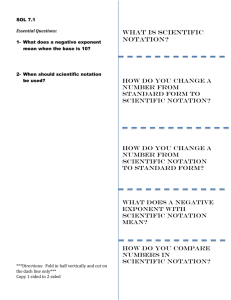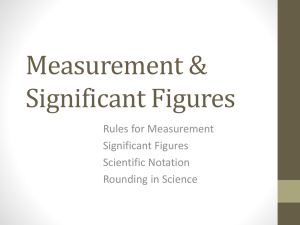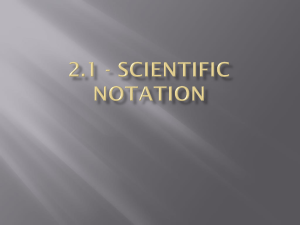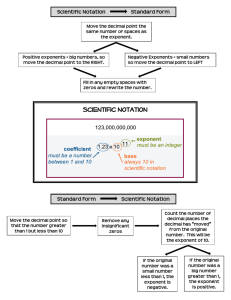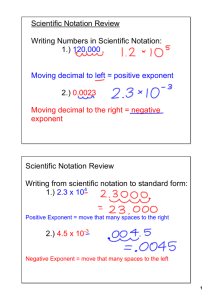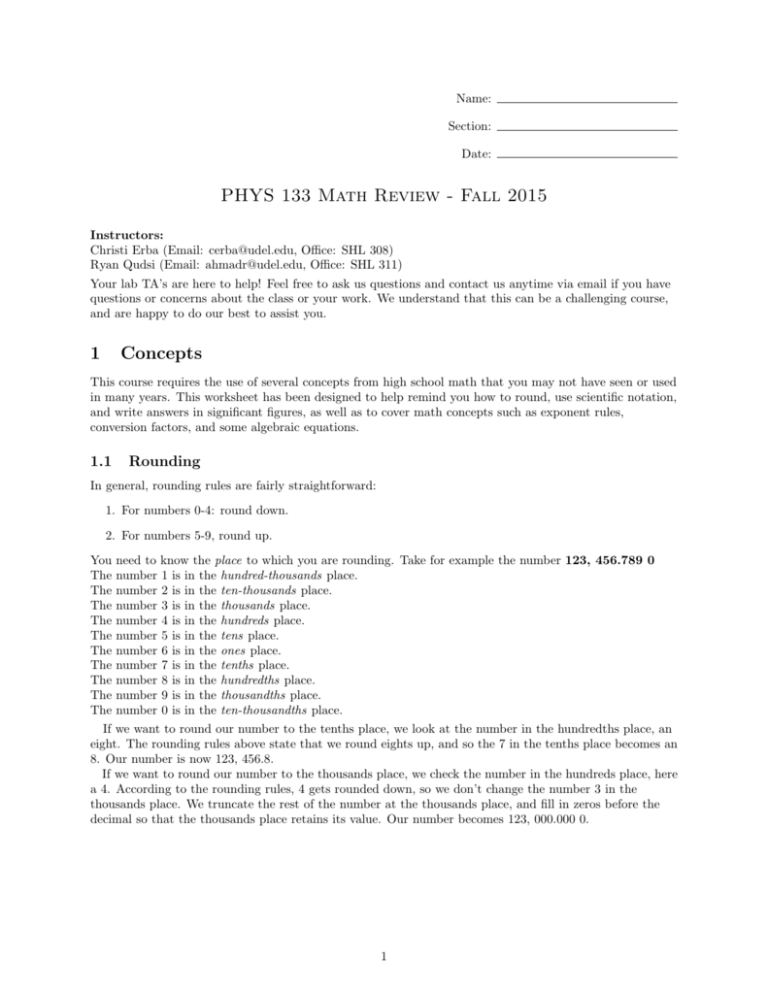
Name:
Section:
Date:
PHYS 133 Math Review - Fall 2015
Instructors:
Christi Erba (Email: cerba@udel.edu, Office: SHL 308)
Ryan Qudsi (Email: ahmadr@udel.edu, Office: SHL 311)
Your lab TA’s are here to help! Feel free to ask us questions and contact us anytime via email if you have
questions or concerns about the class or your work. We understand that this can be a challenging course,
and are happy to do our best to assist you.
1
Concepts
This course requires the use of several concepts from high school math that you may not have seen or used
in many years. This worksheet has been designed to help remind you how to round, use scientific notation,
and write answers in significant figures, as well as to cover math concepts such as exponent rules,
conversion factors, and some algebraic equations.
1.1
Rounding
In general, rounding rules are fairly straightforward:
1. For numbers 0-4: round down.
2. For numbers 5-9, round up.
You
The
The
The
The
The
The
The
The
The
The
need to know the place to which you are rounding. Take for example the number 123, 456.789 0
number 1 is in the hundred-thousands place.
number 2 is in the ten-thousands place.
number 3 is in the thousands place.
number 4 is in the hundreds place.
number 5 is in the tens place.
number 6 is in the ones place.
number 7 is in the tenths place.
number 8 is in the hundredths place.
number 9 is in the thousandths place.
number 0 is in the ten-thousandths place.
If we want to round our number to the tenths place, we look at the number in the hundredths place, an
eight. The rounding rules above state that we round eights up, and so the 7 in the tenths place becomes an
8. Our number is now 123, 456.8.
If we want to round our number to the thousands place, we check the number in the hundreds place, here
a 4. According to the rounding rules, 4 gets rounded down, so we don’t change the number 3 in the
thousands place. We truncate the rest of the number at the thousands place, and fill in zeros before the
decimal so that the thousands place retains its value. Our number becomes 123, 000.000 0.
1
1.2
Exponent Rules
Exponents represent the number of times you multiply a number or quantity by itself. Multiplied
quantities with the same base have added exponents; divided quantities have subtracted exponents:
22 × 23 = 25
(1 + x)12 /(1 + x)9 = (1 + x)3
Exponents with different bases have to be evaluated before multiplication, division, addition, or
subtraction operations (recall your PEMDAS rules from elementary and middle school!).
If you want to raise an exponentiated number to another exponent, multiply the two exponents together:
(104 )5 = 1020
Any base to the 0th power returns 1. Any base raised to the 1st power returns the base:
x0 = 1, x1 = x
Powers of ten are one particular application of exponents that generally can be divided into two categories:
1. Positive exponents represent the number of zeros added to the right of the original number.
2. Negative exponents represent the number of zeros added to the left of the original number.
In general, when we aren’t dealing with powers of 10, negative exponents represent reciprocals, that is, one
over the given base:
1
x−5 = 5
x
Finally, Roots are just fractional powers, so we can write a square root as follows:
√
1
22 = 2
The multiplication-addition and division-subtraction rules for fractional powers are the same:
1
1
3
2 2 × 2 4 = 2 4 , 33 ÷ 3
1.3
−3
2
9
= 32
Prefixes
Prefixes are a “short-hand,” a way of writing powers of ten (and therefore scientific notation) in words.
They are placed at the front of a unit and describe how many powers of ten are attached to the end of the
listed number.
The following prefixes will be used regularly in lab this semester; you will want to memorize these and
become comfortable with using them:
• G (giga) is one billion, that is 109
• M (mega) is one million, that is 106
• k (kilo) is one thousand, that is 103
• c (centi) is one hundredth, that is 10−2
• m (milli) is one thousandth, that is 10−3
• µ (micro) is one millionth, that is 10−6
• n (nano) is one billionth, that is 10−9
Example 1: Write 2.7 × 106 parsecs using a prefix.
Answer 1: 2.7 Mpc
Example 2: Write 4.8 centimeters in scientific notation.
Answer 2: 4.8 × 10−2
2
1.4
Scientific Notation
Scientific notation is an easy way to write out long numbers. It proves particularly useful with exponents,
simplifies calculations, and makes your work easier to read. In this class, use of scientific notation is a must.
To convert a number into scientific notation, first move the decimal point until it’s placed to the right of
the first non-zero digit. The number of decimal places moved will be the power of ten you use. Moving the
decimal point to the left corresponds to a positive power of ten; similarly, moving the decimal point to the
right corresponds to a negative power of ten:
1945 = 1.945 × 103
0.001945 = 1.945 × 10−3
Converting a number out of scientific notation uses the opposite convention: moving the decimal point to
the left corresponds to a negative power of ten; similarly, moving the decimal point to the right
corresponds to a positive power of ten. If needed, use zeros as place markers:
2.945 × 10−3 = 0.002945
7.014 × 102 = 701.4
Operations in scientific notation are similar to those with normal notation. To add and subtract, you
usually need to switch out of scientific notation (or use the appropriate function on a calculator); however,
if the numbers you are adding or subtracting have the same power of ten attached to them, you can factor
the power of ten out (see example below). To multiply and divide, separate the powers of ten from the rest
of the number and compute the two parts separately:
(1.2 × 102 ) + (1.4 × 102 ) = 2.6 × 102
(3 × 102 ) × (4 × 104 ) = 12 × 106 = 1.2 × 107
(8 × 10−2 )/(2 × 105 ) = 4 × 10−7
1.5
Significant Figures
Significant figures are important when performing calculations, as they reflect the precision of the
measurement taken or data reported. The following list, borrowed from the University of South Carolina at
Aiken’s General Chemistry class1 , sums up the basic rules needed for working with significant figures in a
lab setting:
1. All non-zero numbers are always significant.
2. All zeros between non-zero numbers are always significant.
3. All zeros which are simultaneously to the right of the decimal point and at the end of the number are
always significant.
4. All zeros which are to the left of a written decimal point and are in a number greater than or equal to
ten are always significant.
1 “Significant
Figures - Rules.” Significant Figures - Rules. University of South Carolina Aiken, n.d. Web. 23 Aug.
2014. <http://www.usca.edu/chemistry/genchem/sigfig.htm>, “Significant Figures - Mathematical Operations.” Significant
Figures - Mathematical Operations. University of South Carolina Aiken, n.d. Web. 23 Aug. 2014. <http://www.usca.edu/
chemistry/genchem/sigfig2.htm>.
3
5. If you can write the number in scientific notation and get rid of the zeros, the zeros are NOT
significant.
6. When adding or subtracting numbers, count the number of decimal places to determine the number
of significant figures. The answer cannot contain more places after the decimal point than the
smallest number of decimal places in the numbers being added or subtracted.
7. When multiplying or dividing numbers, count the number of significant figures. The answer cannot
contain more significant figures than the number being multiplied or divided with the least number of
significant figures.
Here are some examples:
0.0369 has three significant figures
107.3 has four significant figures
27.0 has three significant figures
0.003070 has four significant figures
35.7 + 0.09 + 10.1 + 1100 = 1145.89, which we round to 1145.9 to have one decimal place.
410. × 15 ÷ 3.0 = 2050, which we round to 2100, to have 2 significant figures.
1.6
Conversion Factors
Conversion factors are a way to switch between units. They allow you to keep track of all your steps (and
powers of ten) in one line!
Example: How many kilometers are in a centimeter? Even if this conversion initially looks intimidating, we
can break it down into pieces that are more easily understandable. Let’s first set up our conversion factor,
placing the units we are trying to get to in the numerator, and those we are trying to remove in the
denominator:
? cm
?m
×
=? cm
? km
?m
Now, look at the prefixes attached to the unit “meters:” at the beginning, we have “kilo,” which refers to
1000 = 103 , and at the end we have “centi,” which means .01 = 10−2 . Let’s plug those in to the expression
we have above:
(1km) ×
103 m 102 cm
×
= 105 cm
1km
1m
As shown, once you have the prefixes plugged in, your conversion factor is complete, and all you have to
worry about is multiplying powers of ten. Note that all the units, except the one you’re trying to get to,
cancel out! Just add the exponents and you’re done.
Let’s try another example: how many seconds are in a year? See if you can follow each conversion:
(1km) ×
(1yr) ×
365.25d 24hr 60min
60s
×
×
×
= 31, 557, 600.00s = 3.15576 × 107 s
1yr
1d
1hr
1min
One final example: how many parsecs (pc) are in a lightyear (ly)? How many lightyears are in an AU?
The first thing to realize is that the units AU, lightyears, and parsecs are all units of distance. The next
step is to convert these foreign-looking units into something we recognize (it’s ok if you have to look up
some of these numbers):
1AU = 1.496 × 1011 m
1parsec = 3.086 × 1016 m
4
Now that we have these conversions in front of us, let’s set up the conversion factors:
2.998 × 108 m 3.15576 × 107 s
1pc
×
× (1yr) = 9.461 × 1015 m ×
= 3.066 × 10−1 pc
1s
yr
3.086 × 1016 m
1ly
m = 1.581 × 10−5 ly
1AU = 1.496 × 1011 m ×
9.461 × 1015
1ly ×
Endnotes: Note the “Exponent Rules”: and “Scientific Notation” portions of this worksheet are closely adapted from
Appendix C of Bennett, Jeffrey O., Megan Donahue, Nicholas Schneider, and Mark Voit. The Essential Cosmic Perspective.
4th ed. San Francisco: Pearson/Addison Wesley, 2008. Print.
Worksheet problems partially adapted from“Dynamically Created Math Worksheets.” Math Worksheets. Math-Aids.com, n.d.
Web. 29 Dec. 2014. <http://www.math-aids.com/>. and from “Free Algebra 1 Worksheets.” Test and Worksheet Generators
for Math Teachers. Kuta Software, LLC, 2015. Web. 1 Sept. 2015. <https://www.kutasoftware.com/free.html>. This
worksheet was developed by Christiana Erba for the University of Delaware’s PHYS 133 Lab Class, last updated by the author
on September 1, 2015. Some exercises and source material have been borrowed from cited sources.
5
Name:
Section:
Date:
2
Worksheet
One point per problem, 45 problems, 45 points total. Answers are either correct or incorrect, no partial
credit is given. When applicable, include units. You may turn in just the worksheet, which is due at your
first lab section.
2.1
Rounding
Example: Round 324.435 to the nearest ones place. Answer: 324.
1. Round 1895.376 to the nearest tenth
2. Round 709.2353 to the nearest tens place
3. Round 2389.0453 to the nearest hundredth
4. Round 78891.5578032 to the nearest ones place
5. Round 986.22 to three significant figures
6. Round 90723.679234 to two significant figures
7. Round 30352.302857 to the nearest ten-thousandth.
6
Name:
Section:
Date:
2.2
Exponent Rules
Compute the following numbers. You may leave variables in the expressions where appropriate.
Example: (3 × 104 ) × (2 × 102 ) = 6 × 106
8. (3s3 k)5
9. (24 ) × (22 ) ÷ (28 )
2 6
r 3
10. ( 5h
9hr 4 )
11. (3c3 × 4c2 )2
12. 36 ÷ 34 ÷ 3−3
3
13. ( 995 )3
14. kz × 8k 5 z 3
15. 6b5 × 3b−2 × 2b−5
7
Name:
Section:
Date:
2.3
Prefixes
Translate the written-out units attached to the numbers into the same units, but with the proper prefixes
(and units!) attached. You may work with the numbers given; no need to put them into scientific notation.
Example: 240 femtometers = 240 fm.
16. 13 billion years
17. 200 thousand meters
18. 12 thousandths of a second
19. 6536 billionths of a meter
20. 6.023 million meters
21. 324 hundredths of a meter
22. 75 millionths of a second
8
Name:
Section:
Date:
2.4
Scientific Notation
Write the following numbers or answers in proper scientific notation:
Example: 7800 = 7.8 × 103
23. (2 × 10−4 )(8.1 × 10−1 )
24. (2.32 × 10−6 )(4 × 10−5 )
25. (6 × 103 )(9.91 × 100 )
26. (8.9 × 105 )4
27. (4 × 10−5 )−6
28.
8.42×103
5×102
29.
4.1×104
1.28×10−5
9
Name:
Section:
Date:
2.5
Conversion Factors
Hint: Remember Units!
30. Convert 5896.4 angstroms to nanometers.
31. Convert 397.24 kilometers to meters.
32. Convert 12 AU to centimeters.
33. Convert
√
2/2 radians to degrees.
34. Convert 20 years to seconds.
35. Convert 1 parsec (pc) to kilometers, using AU and centimeters as intermediate conversions. Hint:
Convert pc to AU, AU to cm, then cm to km.
10
2.6
Algebraic Manipulation
Solve the following equations for the specified variable. For the word problems, solve for the quantity in the
question:
36.
7
b+5
37.
4
m−8
=
38.
4
9
r−3
6
=
=
10
5
8
2
39. a + 5 = −5a + 5
40. p − 1 = 5p + 3p − 8
41. 5n + 34 = −2(1 − 7n)
42. −3(4x + 3) + 4(6x + 1) = 43
43. −5(1 − 5x) + 5(−8x − 2) = −4x − 8x
11
44. An aircraft carrier made a trip to Guam and back. The trip there took three hours and the trip back
took four hours. It averaged 6 km/hr on the return trip. Find the average speed of the trip there.
45. A passenger plane made a trip to Las Vegas and back. On the trip there it flew 432 mph and on the
return trip it went 480 mph. How long did the trip there take if the return trip took nine hours?
12


